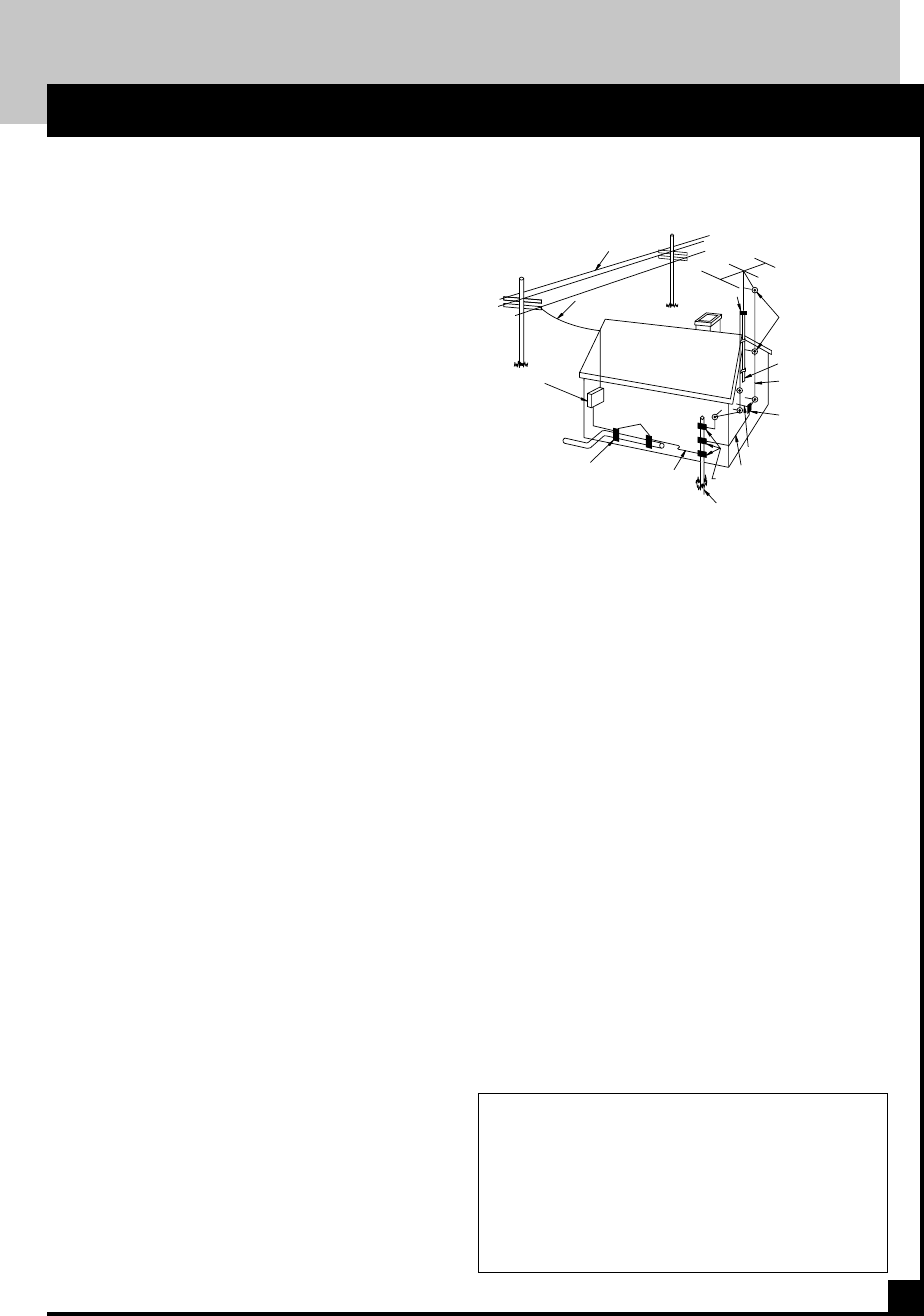
PICO MACOM INC.
12500 Foothill Blvd., Lakeview Terrace, CA 91342 • (818) 897-0028 • (800) 421-6511 • FAX (818) 834-7197
2
Importent Information con't
SAFEGUARDS
STANDOFF
INSULATORS
b
MAST
ANTENNA
LEAD-IN WIRE
c
GROUND WIRE
TO EXTERNAL ANTENNA
TERMINALS OF PRODUCT
ANTENNA
DISCHARGE UNIT
GROUND CLAMPS
OPTIONAL ANTENNA GROUNDING ELECTRODE
DRIVEN 8 FEET (2.44M) INTO THE EARTH
IF REQUIRED BY LOCAL CODES. SEE NEC
SECTION 810 - 21(f).
BONDING JUMPER
d
G
R
O
U
N
D
C
L
A
M
P
S
POWER SERVICE GROUNDING
ELECTRODE SYSTEM
(e.g. interior metal water pipe)
SERVICE
ENTRANCE
EQUIPMENT
SERVICE ENTRANCE
CONDUCTORS
GROUND CLAMP
POWER LINES
EXAMPLE OF ANTENNA GROUNDING ACCORDING TO
NATIONAL ELECTRICAL CODE INSTRUCTIONS CONTAINED
IN ARTICLE 810 - "RADIO AND TELEVISION
EQUIPMENT"
19. Replacement Parts - When replacement parts are required, be sure the
service technician has used replacement parts specified by the manufac-
turer or have the same characteristics as the original parts. Unauthorized
substitutes may result in fire, electric shock or other hazards.
20. Safety Check - Upon completion of any service or repairs to this
product, ask the service technician to perform safety checks to
determine that the product is in proper operating conditions.
21. Outdoor Antenna Grounding - Before attempting to install this
product, be sure the antenna or cable system is grounded so as to
provide some protection against voltage surges and built-up static
charges.
a. Use No.10 AWG (5.3mm ) copper, No.8 AWG (8.4mm (alumi-
num, No.7 AWG (10mm ) copper-clad steel or bronze wire or larger,
as ground wire.
b. Secure antenna lead-in and ground wires to house with stand-off
insulators spaced from 4 feet (1.22m) to 6 feet (1.83m) apart.
c. Mount antenna discharge unit as close as possible to where lead-
in enters house.
d. A driven rod may be used as the grounding electrode where other
types of electrode systems do not exist. Refer to the National
Electrical Code, ANSI/NFPA 70-1984 for information.
e. Use jumper wire not smaller than No.6 AWG (13.3mm ) copper
or equivalent, when a separate antenna grounding electrode is used.
NOTE TO THE CATV SYSTEM INSTALLER:
THIS REMINDER IS PROVIDED TO CALL THE CATV
SYSTEM INSTALLER’S ATTENTION TO ARTICLE 820 -
40 OF THE NEC THAT PROVIDES GUIDELINES FOR
PROPER GROUNDING AND, IN PARTICULAR, SPECI-
FIES THAT THE CABLE GROUND SHALL BE CON-
NECTED TO THE GROUNDING SYSTEM OF THE BUILD-
ING, AS CLOSE TO THE POINT OF CABLE ENTRY AS
PRACTICAL.
10. Grounding or Polarization - This video product is equipped
with a polarized alternating - current line plug (a plug having one
blade wider than the other). This plug will fit into the power socket
only one way. This is a safety feature. If you are unable to insert the
plug full into the outlet, try reversing the plug. If the plug should still
fail to fit, contact your electrician to replace your obsolete outlet.
Do not defeat the safety purpose of the polarized plug.
11. Power Sources - This product should be operated only from the
type of power source indicated on the marking label. If you are not
sure of the type of power supplied to your home, consult your
appliance dealer or local power company.
12. Power-cord Protection - Power-supply cords should be routed
so they are not likely to be walked on or pinched by items placed
upon or against them. Pay particular attention to cords and plugs,
convenience receptacles, and the point where they exit from the
appliance.
13. Lightning - For added protection for this product during a
lightning storm, or when it is left unattended or unused for long
periods of time, the unit should be disconnected.
14. Power Lines - An outside antenna system should not be located
in the vicinity of overhead power lines, other electric light or power
circuits, where it can fall into such power lines or circuits. When
installing an outside antenna system, extreme care should be taken
to keep from touching power lines or circuits as contact with them
may be fatal.
15. Overloading - Do not overload wall outlets and extension cords
as this can result in risk of fire or electric shock.
16. Object and Liquid Entry - Never push objects of any kind into
this product through openings as they may touch dangerous voltage
points or short-out parts that could result in a fire or electric shock.
Never spill liquid of any kind on the product.
17. Servicing - Do not attempt to service this product yourself as
opening or removing covers may expose you to dangerous voltage
or other hazards. Refer all servicing to qualified service personnel.
18. Damage Requiring Service - Unplug this product from the wall
outlet and refer servicing to qualified service personnel under the
following conditions:
a. When the power-supply cord or plug is damaged.
b. If liquid has been spilled, or objects have fallen into the product.
c. If the product has been exposed to rain or water.
d. If the product does not operate normally by following the
operating instruction. Adjust only those controls that are covered by
the operating instructions. An improper adjustment may result in
damage and will often require extensive work by a qualified tech-
nician to restore the product to its normal operation.
e. If the product has been dropped or the cabinet has been damaged.
f. When the product exhibits a distinct change in performance - this
indicates a need for service.














